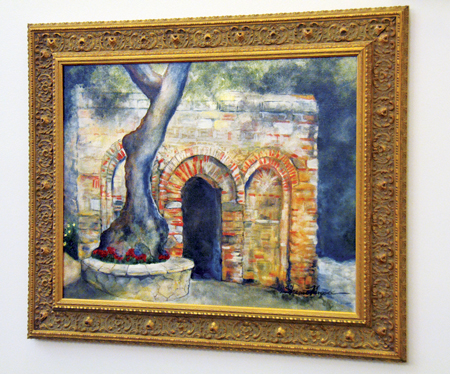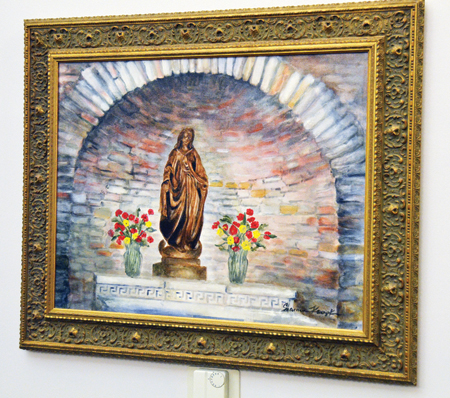Kansas Citians Honor Our Lady Of Ephesus In Many Ways, Including A Film

Meryem Ana Evi, Mary’s House, painted by Shannon Knopke, hangs in the Chapel of Our Lady of Ephesus in the Catholic Center. (Marty Denzer/Key photo)
By Marty Denzer
Catholic Key Reporter
Catholic Key Reporter
KANSAS CITY — Movie goers rush to see the latest film, stories of fantasy, romance or violence. A film now in its infant stages will tell a very different story, one that is 2,000 years old but mostly unknown until now. Our Lady of Ephesus – The Journey Home, the story of Mary, the Mother of Jesus Christ.
Mary lived more than 20 centuries ago, but her continued influence, intercession and spirituality inspire men and women, both Christian and Muslim. We know little about Mary, as the Bible mentions her but rarely. What we do know comes from St. John’s Gospel, documents such as Theotokus (431), the dogmas of the Immaculate Conception (1854) and the Assumption (1950). We also know something about Mary’s last years from the visions of Blessed Anne Catherine Emmerich.
Moments before his death on the Cross, Jesus looked down and saw his mother and the Apostle John. He spoke to them both saying, “Woman behold your son,” and “Son, behold your mother.” Thus it has come down over the centuries that Jesus gave Mary into the care of John, who “from that hour, took her into his own home.” (John 19:26-27)
Christian tradition holds that John took Mary to Ephesus, now in modern Turkey, to escape the persecution of Christians that began soon after Jesus’ death, Resurrection and Ascension. He found a house, repaired and remodeled it to provide her with a cozy shelter while he wrote his Gospel, evangelized and built a church.
There is evidence, contrary to Jerusalem’s claims, that Mary died in Ephesus and was assumed into heaven there.
Turkey today is predominantly Muslim. Even so, the Qur’an mentions Mary, in fact, more often than the New Testament, and Islam reveres her.
Sister Anne Catherine Emmerich, a German Augustinian nun, mystic and stigmatic, received visions of the last years of Mary’s life, which she related to the poet Clemens Brentano before her death in 1824. The revelations, one of which detailed that Mary’s House “was the only one built of stone” in the village near Ephesus, were published in a book in 1852.
The book was read by a French Daughter of Charity, Sister Marie de Mandat-Grancey and shared with her community. Later when she was assigned as Superior of the Daughters of Charity community and an orphanage in Smyrna, Turkey, she realized that she was not far from the site of Emmerich’s visions.
She persuaded two Lazarist (Vincentian) priests, Fathers Eugene Poulin and Henri Jung, to follow Emmerich’s clues and see if they could find Mary’s House. In 1891, the Father Jung and another Lazarist priest, Father Benjamin Vervault, found the house. Sister Marie spent the rest of her life and much of her personal, inherited fortune restoring the house and its surroundings. She died in 1915 and is buried in Izmir, formerly Smyrna.
Sister Marie was named Foundress of Mary’s House by the Catholic Church. The discovery revived and strengthened the 700-year-old ‘tradition of Ephesus,’ which has competed with the ancient ‘Jerusalem tradition’ about the place of the Blessed Virgin’s death and Assumption into heaven.
Begun by Pope Leo XIII in 1896 and completed by Pope John XXIII in 1961, the Catholic Church first removed plenary indulgences from the Church of the Dormition in Jerusalem and then bestowed them, in perpetuum, for all time, to pilgrims to Mary’s House in Ephesus.
Over the years, the house, known locally as Panaghia-Capouli (Door of the Holiest), fell into disrepair and sustained water damage from heavy storms.
World-wide attention focused on Mary’s House when Pope Pius XII declared the Dogma of the Assumption of Mary in 1950.
Five years later, American businessman George Bertrand Quatman and his wife made a pilgrimage to Ephesus to thank and honor the Blessed Virgin Mary for curing their grandson of polio. The Quatmans were appalled at the disrepair and neglect they saw at Mary’s House, the Tomb of St. John and the 6th century Basilica of St. John. The Church of Mary, site of the Ecumenical Council of 431 where Mary was declared Theotokus, Mother of God, was in similar condition.
When he returned home, George Quatman established the American Society of Ephesus to preserve and protect Mary’s House, and the three other Ephesian shrines. More than a half-century later, his grandson, Bill Quatman, gave a talk on Ephesus and its treasures to fifth graders in his wife’s class at St. Elizabeth School.
A student, Madeline Knopke, told her mother, Shannon, about the talk and drew a picture of Mary’s House that evening to give to her grandmother. Shannon, an artist and actress, was moved and intrigued. She began researching and studying everything she could find about Mary’s House, Ephesus and the history and faith traditions surrounding it.
Over the ensuing years, Shannon Knopke continued her research into Mary’s House, continued her professional work in art and acting, and being mom to Madeline, Joseph and Mara. She also became acquainted with Bill Quatman and his family.
In the meantime, Bishop Robert W. Finn of the Diocese of Kansas City-St. Joseph accepted the charge to open the cause of Sister Marie de Mandat-Grancey for sainthood. The Catholic Church had named Sister Marie, “Foundress of Mary’s House,” and her work to restore and preserve the ancient home had been a catalyst to George Quatman and his descendants as well as to others who honored and were devoted to her.

A statue of Mary stands on the altar in Mary’s House in Ephesus. This painting, by Shannon Knopke, hangs next to a painting of Mary’s house, also by Knopke, in the Chapel of Our Lady of Ephesus in the Catholic Center.
In 2011, not long after the offices of the Diocese of Kansas City-St. Joseph moved into the late 19th century New York Life Building downtown and renamed it The Catholic Center, a first floor conference room was remodeled to form the Chapel of Our Lady of Ephesus. The chapel was dedicated Aug. 15, 2011, the Feast of the Assumption of Mary.
Among those interested in the transformation of a rather bleak conference room into the vibrant Chapel of Our Lady of Ephesus was Bill Quatman. He commissioned two paintings from Shannon Knopke — one of Mary’s House and one of a statue of Mary that stands on the altar inside the home. The framed works were recently presented to Bishop Finn and hang in the Chapel of Our Lady of Ephesus.
A scale model of Mary’s House was lovingly constructed by Cure of Ars parishioner Harold Mueller and given to Bishop Finn recently. Mueller is retired and “now has the time to do unusual, spiritual things.” He learned about Ephesus and the Quatman family through a Bible Study Group friendship with Bill Quatman’s brother-in-law, Jim Lynch.
He became interested in Ephesus and over a period of 8 – 9 months, built the model. It now has pride of place in the hall near the Bishop’s office at the Catholic Center.
The bishop has made two trips to Ephesus to visit Mary’s House, the first time in October 2007. He had seen photographs and read about Mary’s House, but to actually enter the small stone house, “… actually going into the house and kneeling down … it was like coming to my mother’s home. It seemed a very calm, quiet, holy place.”
His second visit was in October 2011, with members of the Tribunal for the Cause of Sister Marie de Mandat-Grancey for sainthood, including Quatman.
A year later, Quatman returned to Ephesus, accompanied this time by Shannon Knopke and videographer Shawn Cloud. Knopke went with the intention of filming a documentary of Ephesus, Mary’s House and the people who make pilgrimages to Meryem Ana Evi (Mary’s House), both Christian and Muslim.
Knopke said that “finally going to a place I’d heard and learned about for the past five years … was seeing concrete, physical evidence of my faith. The house is on a hill and all you hear is nature. Ephesus is very busy and loud and, with a population 2,000 years ago of 250,000, it was very busy and loud then. You can see why John built her a house away from all that craziness. Sunset on the house was quietly beautiful.”
The little group were there three days, filming and interviewing some of the priests who live near Mary’s House, the Archbishop of Izmir, Ruggero Franceschini, OFM, Cap., Baroness Rosario de Mandat-Grancey, and speaking with pilgrims, both Christian and Muslim.
When she returned to Kansas City, Knopke began work on the documentary. She said she wants the story told in a way that will honor Mary, and educate people. Many phone calls, many meetings with the videographer, Quatman, religious and lay people later, a synopsis of the documentary was written.
In part it says: “Biblical scholars agree that when it became too dangerous for the Apostles to remain in Jerusalem, they left to preach Jesus’ message in other lands. John went to what was then known as Asia Minor, to the great seaport of Ephesus, the third-largest city in the Roman Empire with a population of 250,000.
“The year was between 42-48 A.D., and the film will depict Mary’s first ocean crossing, from Jerusalem to Ephesus, across the Aegean Sea. We will see the arrival of John and Mary as refugees …
“We will see how John began his ministry, and how Apostles like St. Luke and converts like St. Paul ventured in and out of Ephesus, spreading the good news, meeting with John and Mary to tell their stories and share meals and prayer.
We will follow Mary as she walks the Stations of the Cross, marked by stones she has set up on the hillside behind her house.
“The film will depict the Dormition (death) of Mary, surrounded by the Apostles and her maidservant; her burial in a cave in that mountain, followed by her Assumption into Heaven. Four centuries later, in 431 A.D., we will see more than 250 bishops convene the historic Council of Ephesus to declare Mary “Theotokos” or Mother of God, confirming the divinity of Jesus at birth for all time in a torch-lit nighttime procession.”
There will be glimpses of Sister Anne Catherine Emmerich, flashes of Sister Marie de Mandat-Grancey as a child, and scenes of the Lazarist priests discovering the house.
“Pope Leo XIII will declare the house a shrine in 1896, and thousands of pilgrims will arrive annually. Following WWII, the house will be restored with assistance of an American family and pilgrimages will resume. Over 1 million Muslim and Christian visitors will pay respect at this modest and peaceful place each year, as have the last three popes, Paul VI, John Paul II and Benedict XVI. The film will pay respect to the Blessed Mother, depicting her grief, her life, her Dormition and her Assumption.”
Through industry contacts, Knopke has sparked interest in the future documentary with a producer and others in Hollywood, but that’s for the future. Right now, she seeks funding for the next steps: hiring a consultant, assembling a trailer and marketing it to Hollywood.
Mary continues to comfort and inspire people worldwide, and many seek to honor her.
Maronite Sister Rafka, Philadelphia, has sought permission from Maronite Bishop Gregory Mansour to set up a hermitage near Mary’s House and live as a hermit nun for the remainder of her life. Archbishop Franceschini has enthusiastically approved the transfer. Sister Rafka is in the process of securing the permission and pulling up stakes.
Perhaps the future holds more ways to honor Jesus’ mother, and Our Lady of Ephesus – The Journey Home may be one of them.












